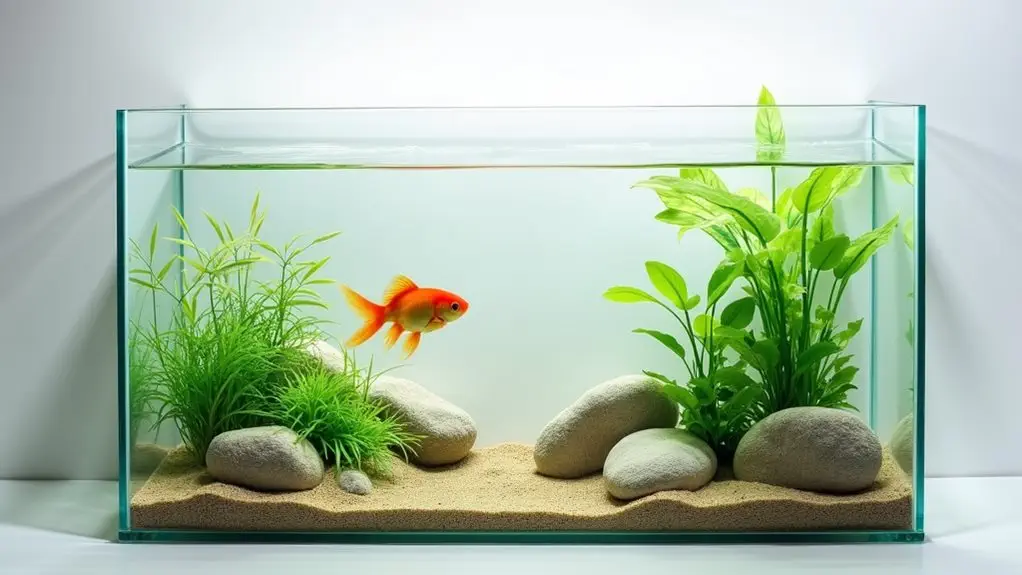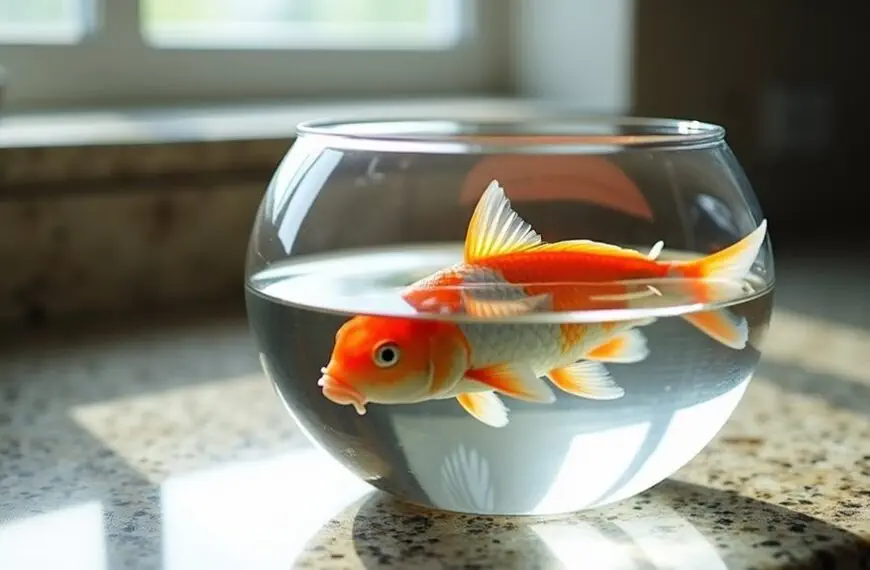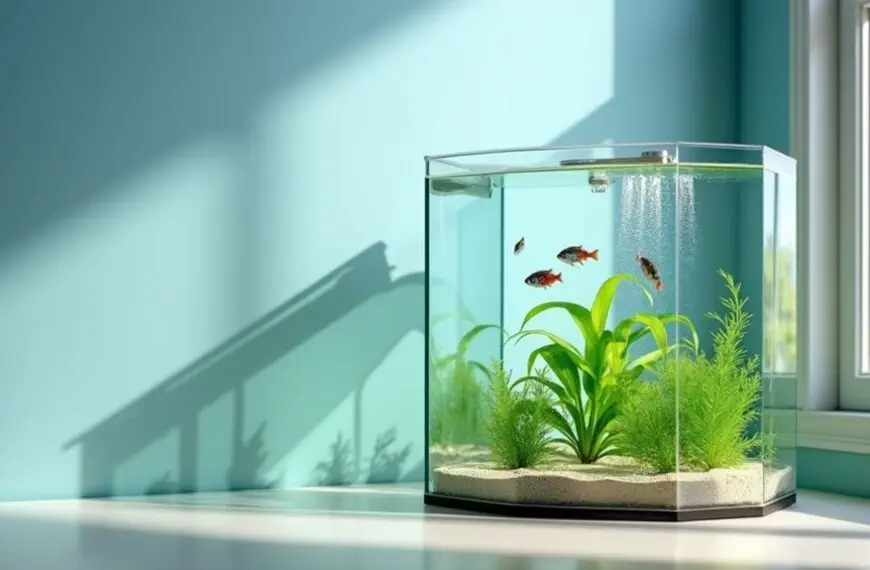For a single goldfish, you'll need at least 20-35 gallons of water, depending on whether you have a fancy or common variety. While this might seem like a lot, your finned friend needs plenty of swimming space to thrive and grow to their full potential. Common goldfish can reach up to 12 inches long and produce significant waste, so a larger tank helps maintain water quality and reduces stress. A tank that's longer rather than taller works best, as goldfish prefer horizontal swimming space. There's much more to evaluate about tank dimensions and setup to keep your aquatic buddy happy and healthy.
Contents
Understanding Goldfish Tank Size Requirements
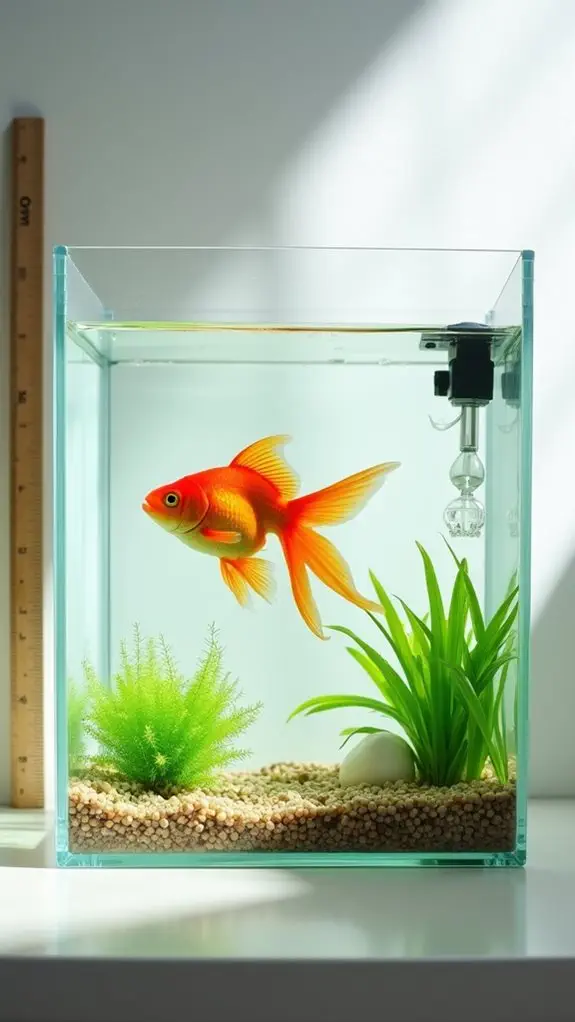
Understanding goldfish behavior helps explain why size matters so much. These active swimmers love to explore their environment, and they'll use every inch of space you give them. They're also notorious waste producers, which means a larger tank helps maintain better water quality. A well-sized tank supports stable conditions, ensuring your goldfish can thrive. Common goldfish varieties like comets and shubunkins need even more space, requiring a minimum of 35 gallons per fish. A single comet goldfish can grow up to 12 inches long in optimal conditions.
You've probably heard the myth that goldfish will only grow to fit their tank – while there's some truth to this, it's actually because smaller tanks can stunt their growth and harm their health.
When choosing your tank, opt for one that's longer rather than taller. Your goldfish will appreciate the horizontal swimming space, and they'll experience less pressure than in a tall tank.
Common Versus Fancy Tank Needs
When diving into goldfish varieties, you'll notice distinct differences between common and fancy goldfish that directly impact their tank requirements.
Common goldfish, with their streamlined bodies and single tails, need considerably more space – at least 35 gallons, though they'd be much happier in a 64-gallon tank or, even better, a pond. Think of them as the marathon swimmers of the goldfish world! Regular tank cleaning helps maintain optimal conditions for these active swimmers. It's important to remember that maintaining clean water quality is crucial for their health and longevity.
Your fancy goldfish, on the other hand, are a bit like the synchronized swimmers of the bunch. With their rounder bodies and flowing double tails, they can manage in slightly smaller spaces, needing a minimum of 25 gallons. With proper care and space, these beautiful fish can live 10-15 years in captivity. However, they still prefer at least 37 gallons to truly thrive. While you might be tempted to squeeze them into a smaller tank, remember that both types produce lots of waste and need room to grow.
The tank shape matters too – common goldfish love long, shallow tanks for horizontal swimming, while fancy goldfish appreciate squatter tanks with more surface area for better oxygen exchange.
If you're planning for the long haul, always go bigger than you think you'll need!
Basic Tank Dimension Guidelines

When you're setting up your goldfish tank, you'll want to focus more on length than height since your finned friend needs plenty of horizontal swimming space. This is especially important because goldfish are known to be active swimmers and require ample room to thrive.
Your tank's surface area plays a vital role in oxygen exchange, so a wider, longer tank will serve your goldfish better than a tall, narrow one. A 20-gallon minimum is essential for a single goldfish to thrive.
A good rule of thumb is to choose a tank that's at least six times longer than your goldfish's expected adult size, with enough width to let them turn comfortably without feeling cramped. Keep in mind that common goldfish can reach a length of up to 12 inches in optimal conditions.
Length Vs Height Ratios
Having the right tank dimensions is just as essential as the overall volume when housing goldfish.
When it comes to length preferences, you'll want to prioritize horizontal swimming space over height, as goldfish are natural swimmers who love to cruise from side to side. For a single goldfish, you'll need at least 120cm of length for fancy varieties or 200cm for common goldfish. A minimum of 29 gallons is required for proper housing of fancy goldfish. Additionally, maintaining proper water quality standards is crucial for the overall health of your goldfish.
Height limitations are equally important, and you'll want to keep your tank under 2 feet tall.
Here's why a longer, shorter tank works better for your finned friend:
- Goldfish prefer horizontal swimming patterns and don't need excessive vertical space.
- Lower water pressure reduces stress on your fish's body.
- Better surface area for oxygen exchange.
- Easier maintenance and cleaning for you.
Surface Area Considerations
Surface area plays a major role in your goldfish's health beyond just tank length and height. You'll want to focus on tanks that offer plenty of horizontal swimming space, as this creates a larger surface area where oxygen can enter the water and carbon dioxide can escape.
Think of it like giving your fish their own personal swimming pool with plenty of room to breathe! A proper filtration system setup is crucial since it needs to process the tank water at least four times per hour. Additionally, maintaining regular water quality monitoring ensures a healthy environment for your goldfish.
When choosing your tank shape, remember that wider and longer is better than taller. You don't want to go higher than 2 feet, as this can create uncomfortable water pressure for your finned friend.
For a single fancy goldfish, you'll need a minimum tank size of 120cm x 50cm x 50cm, while common goldfish require at least 200cm x 60cm x 60cm. That might sound big, but your goldfish will thank you!
The surface area is particularly important if you've got a fancy goldfish with elaborate head growth – they need that extra oxygen exchange at the surface.
Plus, a larger surface area means more stable water conditions, which makes your job as a fish parent much easier.
Tank Size Health Benefits
A properly sized tank plays an essential role in your goldfish's health and longevity. When you provide your finned friend with adequate space, you'll notice remarkable health benefits that'll make both of you happier. Your goldfish will have room to swim freely, grow to its full potential, and maintain better overall health. A 20-gallon tank will provide one fancy goldfish sufficient space. With regular maintenance checks, your goldfish can live 10-15 years in optimal conditions. Additionally, a larger tank allows for better water quality through improved waste management.
Here are the key health advantages you'll see with a properly sized tank:
- Better water quality, since waste gets diluted more effectively
- Reduced stress levels, preventing common behavioral issues like glass surfing
- Stronger immune system due to decreased exposure to concentrated waste
- More natural swimming patterns, leading to better muscle development
You'll also find that maintaining a larger tank is actually easier than dealing with a smaller one. Instead of performing daily water changes and constantly worrying about water quality, you'll have a more stable environment that requires less frequent maintenance.
Think of it like giving your goldfish a spacious apartment instead of a cramped closet – they'll thrive with room to move around!
Plus, your goldfish can grow to its full size without the stunting effects that often occur in smaller tanks.
Selecting Your Perfect Tank
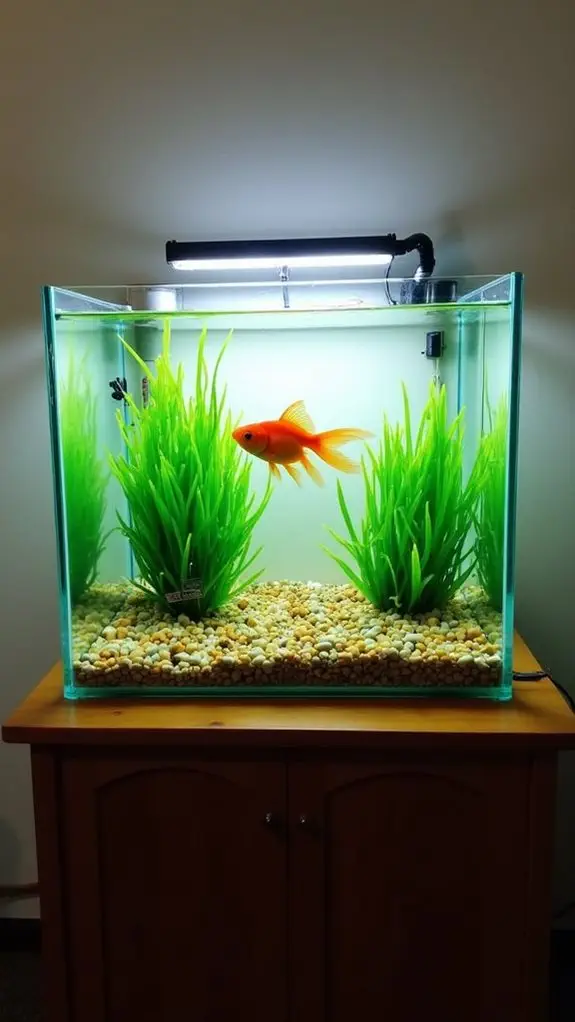
Selecting the perfect tank size involves balancing several essential factors for your goldfish's well-being. When you're browsing for tanks, remember that bigger is usually better – your finned friend will thank you with more active, playful behavior!
For a single fancy goldfish, you'll want at least 25 gallons, while a common goldfish needs 35 gallons minimum.
Think about your tank's shape too – you'll want to choose one that's wider rather than taller. This gives your goldfish plenty of horizontal swimming space and makes it easier to add tank accessories like plants and decorations.
Watch out for tanks over 2 feet tall, as they can create too much water pressure at the bottom.
Consider your goldfish's future growth when selecting tank size. While that 20-gallon tank might look spacious now, your little swimmer could quickly outgrow it!
A larger tank also gives you more flexibility with decorating and maintaining stable water conditions. Remember, your goldfish's activity level will increase with more space, so don't be afraid to go bigger than the minimum requirements if you can. Additionally, providing a spacious environment helps in keeping ammonia and nitrite levels at 0 ppm, which is crucial for your fish's health.
Water Quality and Space Management
Managing your goldfish's water quality goes hand in hand with providing adequate space. When it comes to water filtration and waste management, you'll want to think bigger than you might expect. Your finned friend produces quite a bit of waste, and you'll need enough water volume to dilute it properly.
To maintain ideal water conditions, here's what you'll need to focus on:
- Regular water changes (at least 25% weekly)
- An oversized filter system that processes more water than recommended
- Consistent water quality testing
- Plenty of surface area for proper oxygen exchange
Remember that your goldfish isn't just swimming in that water – it's living, breathing, and, yes, producing waste in it too!
A larger tank makes maintaining clean water much easier, and you won't have to perform water changes quite as frequently. While a smaller tank might seem more convenient, it'll actually create more work for you in the long run. Additionally, a larger tank helps to reduce stress-related behaviors associated with poor water quality.
Think of it this way: a bigger tank is like giving your goldfish a spacious apartment instead of a cramped studio – they'll be healthier, happier, and you'll spend less time on waste management.
Frequently Asked Questions
Can I Temporarily Keep My Goldfish in a Smaller Tank?
You can use temporary housing while tank cycling, but it's not ideal long-term. You'll need frequent water changes and strong filtration. Keep the stay brief to prevent stress and health issues in your goldfish.
How Does Tank Shape Affect My Goldfish's Swimming Patterns?
Your tank's design directly impacts your goldfish's swimming behavior. You'll want a longer, wider tank rather than a tall one, as this matches their natural horizontal swimming patterns and reduces pressure stress.
Should I Choose Glass or Acrylic for My Goldfish Tank?
You'll find glass benefits like scratch resistance and lower cost make it ideal for beginners. However, if you want design flexibility and lighter weight, acrylic advantages might better suit your needs despite higher prices.
At What Age Should I Move My Goldfish to a Larger Tank?
You'll need to monitor your goldfish's growth and shift them to a larger tank within their first year, typically when they reach 2-3 inches. Don't wait too long, as early upgrades prevent stunted growth.
Do Goldfish Prefer Planted Tanks or Open Swimming Spaces?
You'll find most goldfish enjoy a balanced setup. While planted benefits include hiding spots and natural enrichment, they also need open swimming spaces for exercise. Consider combining both to meet their swimming preferences.
Final Thoughts
When you're setting up your goldfish's home, remember that bigger is always better. You'll need at least 20 gallons for a single common goldfish, or 10-15 gallons for a fancy variety. Don't let those tiny bowls at the pet store fool you – your finned friend needs plenty of space to thrive and grow. With the right tank size, you'll have a happy, healthy goldfish that'll be swimming circles around those bowl myths.

